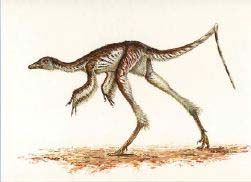Diminutive Dinosaur from China Sheds Light on Bird Evolution

Image: ©Michael Skrepnick/ Courtesy of the Field Museum
Tyrannosaurus rex, Apatosaurus and the other dinosaur giants capture the popular imagination. But paleontologists often focus on smaller fry – especially with regard to the origin of birds, which are believed to have evolved from petite, predatory dinosaurs. Researchers describe one such specimen — the partial skeleton of a previously unknown genus of chicken-size dinosaur that roamed China’s Liaoning province nearly 130 million years ago — today in the journal Nature. According to the report, the novel beast belongs to the troodontid family of dinosaurs and suggests that certain birdlike features arose far earlier than scientists had suspected.
Dubbed Sinovenator changii, the new fossil comes from the same region that last year yielded the spectacularly complete remains of a feathered dinosaur. According to team member Peter Mackovicky of Chicago’s Field Museum, Sinovenator — a close relative of the similarly aged bird Archaeopteryx — probably had feathers, too, although none are preserved in this specimen. The oldest and most primitive troodontid yet found, Sinovenator exhibits several features — its small size, for example —that do not appear in later troodontids but do appear in dromaeosaurids (close relatives of birds) and birds themselves. Troodontids, the researchers say, eventually lost these characteristics as they became bigger.
“It demonstrates that major structural modifications toward birds occurred much earlier in the evolutionary process than previously thought,” Mackovicky asserts. “Furthermore, these findings help counter, once and for all, the position of paleontologists who argue that birds did not evolve from dinosaurs.”
Media Contact
All latest news from the category: Life Sciences and Chemistry
Articles and reports from the Life Sciences and chemistry area deal with applied and basic research into modern biology, chemistry and human medicine.
Valuable information can be found on a range of life sciences fields including bacteriology, biochemistry, bionics, bioinformatics, biophysics, biotechnology, genetics, geobotany, human biology, marine biology, microbiology, molecular biology, cellular biology, zoology, bioinorganic chemistry, microchemistry and environmental chemistry.
Newest articles

Eruption of mega-magnetic star lights up nearby galaxy
Thanks to ESA satellites, an international team including UNIGE researchers has detected a giant eruption coming from a magnetar, an extremely magnetic neutron star. While ESA’s satellite INTEGRAL was observing…

Solving the riddle of the sphingolipids in coronary artery disease
Weill Cornell Medicine investigators have uncovered a way to unleash in blood vessels the protective effects of a type of fat-related molecule known as a sphingolipid, suggesting a promising new…

Rocks with the oldest evidence yet of Earth’s magnetic field
The 3.7 billion-year-old rocks may extend the magnetic field’s age by 200 million years. Geologists at MIT and Oxford University have uncovered ancient rocks in Greenland that bear the oldest…





















